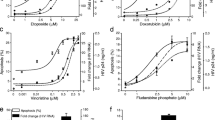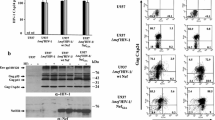Summary
A long period of clinical latency before development of symptoms is characteristic of human immunodeficiency virus type 1 (HIV-1) infection. OM10.1, a promyelocyte cell line latently infected with HIV-1, has been developed as a model for studying the mechanism of viral latency and the activation of virus expression. We found that this latently infected cell line with heat shock at 42°C for 2 h resulted in a high level of HIV-1 production without addition of any cytokines. The mechanism of activation was analyzed by using anti-TNF-α antibody and various inhibitors. Although the TNF-α level in culture supernatants was below the sensitivity of an ELISA assay system, addition of anti-TNF-α antibody in culture medium could partially suppress the heat shock induced HIV-1 production. Staurosporine (PKC inhibitor), pentoxifylline (NF-ϰB inhibitor), and Ro5-3335 (HIV-1 Tat inhibitor) also inhibited significantly the heat shock induced virus activation. In particular, staurosporine achieved approximately 90% inhibition of the HIV-1 antigen expression in heat shock-treated OM10.1 at a non-toxic concentration. Although the mechanism of HIV-1 activation with heat shock has not been fully elucidated yet, it is presumed PKC plays an important role in HIV-1 activation. Thus, the present observations will provide a further insight into the pathogenesis of HIV-1 infections.
Similar content being viewed by others
References
Biswas DK, Dezube BJ, Ahlers CM, and Pardee AB (1993) Pentoxifylline inhibits HIV-1 LTR-driven gene expression by blocking NF-κB action. J Acquir Immune Defic Syndr 6: 778–786
Brown FL, Tahaoglu E, Graham GJ, Maio JJ (1993) Inducible transcriptional activation of the human immunodeficiency virus long terminal repeat by protein kinase inhibitors. Mol Cell Biol 13: 5245–5254
Butera ST, Perez VL, Wu BY, Nabel GJ, Folks TM (1991) Oscillation of the human immunodeficiency virus surface receptor is regulated by the state of viral activation in a CD4+ cell model of chronic infection. J Virol 65: 4645–4653
Butera ST, Roberts BD, Lam L, Hodge T, Folks TM (1994) Human immunodeficiency virus type 1 RNA expression by four chronically infected cell lines indicates multiple mechanisms of latency. J Virol 68: 2726–2730
Clouse KA, Powell D, Washington I, Poli G, Strebel K, Farrar W, Barstad P, Kovacs J, Fauci AS, Folks TM (1989) Monokine regulation of human immunodeficiency virus-1 expression in a chronically infected human T cell clone. J Immunol 142: 431–438
Collins PL, Hightower LE (1982) Newcastle disease virus stimulates the cellular accumulation of stress (heat shock) mRNAs and proteins. J Virol 44: 703–707
Doppler C, Schalasta G, Amtmann E, Sauer G (1992) Binding of NF-κB to the HIV-1 LTR is not sufficient to induce HIV-1 LTR activity. AIDS Res Hum Retroviruses 8: 245–252
Fauci AS (1993) Multifactorial nature of human immunodeficiency virus disease: implications for therapy. Science 262: 1011–1018
Feorino PM, Butera ST, Folks TM, Schinazi RF (1993) Prevention of activation of HIV-1 by antiviral agents in OM10.1 cells. Antiviral Chem Chemother 4: 55–63
Folks TM, Justement J, Kinter A, Dinarello CA, Fauci AS (1987) Cytokine-induced expression of HIV-1 in a chronically infected promonocyte cell line. Science 238: 800–802
Folks TM, Justement J, Kinter A, Schnittman S, Orenstein J, Poli G, Fauci AS (1988) Characterization of a promonocyte clone chronically infected with HIV and inducible by 13-phorbol-12-myristate acetate. J Immunol 140: 1117–1122
Geelen JLMC, Boom R, Klaver GPM, Minnaar RP, Feltkamp MCW, Milligen FJV, Sol CJA, Noordaa JVD (1987) Transcriptional activation of the major immediate early transcription unit of human cytomegalovirus by heat-shock, arsenite and protein synthesis inhibitors. J Gen Virol 68: 2925–2931
Hashimoto K, Shigets S, Baba M (1995) Superantigen toxic shock syndrome toxin-1 (TSST-1) enhances the replication of HIV-1 in peripheral blood mononuclear cells through selective activation of CD4+ T lymphocytes. J Acquir Immune Defic Syndr Hum Retroviruses 10: 393–399
Hsu MC, Schutt AD, Holly M, Slice LW, Sherman MI, Richman DD, Potash MJ, Volsky DJ (1991) Inhibition of HIV replication in acute and chronic infections in vitro by a Tat antagonist. Science 254: 1799–1802
Kinter AL, Poli G, Maury W, Folks TM, Fauci AS (1990) Direct and cytokine-mediated activation of protein kinase C induces human immunodeficiency virus expression in chronically infected promonocytic cells. J Virol 64: 4306–4312
Kretz-Remy C, Arrigo AP (1994) The kinetics of HIV-1 long terminal repeat transcriptional activation resemble those of hsp 70 promotor in heat-shock treated Hela cells. FEBS Lett 351: 191–196
La Thangue NB, Shriver K, Dawson C, Chan WL (1984) Herpes simplex virus infection causes the accumulation of a heat shock protein. EMBO J 3: 267–277
Luznik L, Kraus G, Guatelli J, Richman D, Wong-Staal F (1995) Tat independent replication of human immunodeficiency viruses. J Clin Invest 95: 328–332
Pauwels R, Balzarini J, Baba M, Snoeck R, Schols D, Herdewijn P, Desmyter J, De Clercq E (1988) Rapid and automated tetrazolium-based colorimetric assay for the detection of anti-HIV compounds. J Virol Methods 20: 309–321
Poli G, Kinter A, Justement JS, Kehrl JH, Bressler P, Stanley S, Fauci AS (1990) Tumor necrosis factor-α functions in a autocirine manner in the induction of human immunodeficiency virus expression. Proc Natl Acad Sci USA 87: 782–785
Re MC, Furlini G, Placa ML (1989) Rapid detection of HIV-1 in clinical samples by co-culture with heat-shocked cells. J Virol Methods 26: 313–318
Schlesinger MJ (1989) Heat shock proteins: the search for functions. J Cell Biol 103: 321–325
Stanley SK, Bressler PB, Poli G, Fauci AS (1990) Heat shock induction of HIV production from chronically infected promonocytic and T cell lines. J Virol 145: 1120–1126
Stanley SK, Folks TM, Fauci AS (1989) Induction of expression of human immunodeficiency virus in a chronically infected promonocytic cell line by ultraviolet irradiation. AIDS Res Hum Retroviruses 5: 375–384
Willey RL, Smith DH, Lasky LA, Theodore TS, Earl PL, Moss B, Capon DJ, Martin MA (1988) In vitro mutagenesis identifies a region within the envelope gene of the human immunodeficiency virus that is critical for infectivity J Virol 62: 139–147
Author information
Authors and Affiliations
Rights and permissions
About this article
Cite this article
Hashimoto, K., Baba, M., Gohnai, K. et al. Heat shock induces HIV-1 replication in chronically infected promyelocyte cell line OM10.1. Archives of Virology 141, 439–447 (1996). https://doi.org/10.1007/BF01718308
Received:
Accepted:
Issue Date:
DOI: https://doi.org/10.1007/BF01718308




